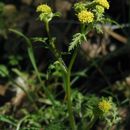Brief Summary
provided by EOL authors
Sanicula tuberosa occurs in Oregon, California and Baja California, Mexico. The chief habitats for the species are open gravelly meadows, chaparral, woodland and pine forest from elevation 50 to 850 meters.
Also known as Turkey pea, this member of the parsley family is a perennial herb rising on a slender stem to a height of 80 centimeters. The stem emerges from a nearly spherical tuber that is up to 15 millimeters in diameter. The compound leaves are typically divided into three leaflets. Inflorescences are comprised of one or more heads of flowers with minute curved yellow petals.
Comprehensive Description
provided by North American Flora
Sanicula tuberosa Torr. Pacif. R. R. Rep. 4 1 : 91. 1857
Hesperogeton tuberosum K.-Pol. Bull. Soc. Nat. Mosc. II. 29: 157. 1916.
Plants erect or spreading, 1-7.5 dm. high, perennial from small, globose tubers 5-15 mm. in diameter, the nodes and summit of the peduncles scaberulous, otherwise glabrous, the stem simple, or divided near the base into divergent branches, each dichotomously or trichotomously branched above; leaves ovate to deltoid in general outline, excluding the petioles 2-13 cm. long, 2.5-8 cm. broad, 1-2-ternate, then pinnate, usually finely dissected, the ultimate divisions acute; petioles 2-8 cm. long; cauline leaves becoming subsessile upward; involucre similar to the upper cauline leaves; involucel of small, ovate to lanceolate, connate bractlets; fertile rays 3, unequal, 5-85 mm. long; sterile and fertile flowers in the same umbellet, the sterile on pedicels 2-7 mm. long; flowers yellow; calyx cleft to the middle, the lobes triangular-ovate, acute, shorter than the petals; anthers yellow, exserted; styles conspicuously spirally coiled, greatly exceeding the calyx; fruit ellipsoid, narrowed at the apex, 1.5-2 mm. long, 2-3 mm. broad, sessile or subsessile, tuberculate with inflated, unarmed tubercles; oil-tubes several on the dorsal and lateral surfaces, 2 on the commissure; seed subterete in cross section, the commissural face plane to slightly concave, the scar linear.
Type locality: Hillsides. Duffield's Ranch, Sierra Nevada, California, Bigelow. Distribution: Southwestern Oregon to southern California (Elmer 3912, Heller 692S, 14,568).
- bibliographic citation
- Albert Charles Smith, Mildred Esther Mathias, Lincoln Constance, Harold William Rickett. 1944-1945. UMBELLALES and CORNALES. North American flora. vol 28B. New York Botanical Garden, New York, NY
Sanicula tuberosa: Brief Summary
provided by wikipedia EN
Sanicula tuberosa is a species of flowering plant in the parsley family known by the common name turkey pea. It is native to western North America from Oregon through California to Baja California, where it can be found in many types of habitat, including chaparral, forests, and woodlands. It is variable in appearance. In general, it is a perennial herb producing a slender stem up to 80 centimeters long from a small, spherical tuber no more than 2 centimeters wide. The leaves are compound, divided into usually three leaflets which are smooth or deeply cut into lobes. The herbage is green to purple in color. The inflorescence is made up of one or more heads of bisexual and male-only flowers with tiny, curving, yellow petals. The fruits are 1 or 2 millimeters long and covered in bumpy tubercles.
- license
- cc-by-sa-3.0
- copyright
- Wikipedia authors and editors

